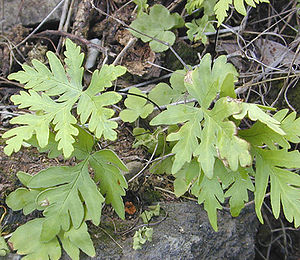Frond

A fern (Dryopteris decipiens) with simple (lobed or pinnatifid) blades, the dissection of each blade not quite reaching to the rachis.

A growing fern frond unfurling.

Unfurling fiddlehead fern frond
A frond is a large, divided leaf.[1] In both common usage and botanical nomenclature, the leaves of ferns are referred to as fronds[2] and some botanists restrict the term to this group.[3] Other botanists allow the term frond to also apply to the large leaves of cycads and palms (Arecaceae).[4][5] "Frond" is commonly used to identify a large, compound leaf, but if the term is used botanically to refer to the leaves of ferns and algae it may be applied to smaller and undivided leaves.
Fronds have particular terms describing their components. Like all leaves, fronds usually have a stalk connecting them to the main stem. In botany, this leaf stalk is generally called a petiole, but in regard to fronds specifically it is called a stipe, and it supports a flattened blade (which may be called a lamina), and the continuation of the stipe into this portion is called the rachis. The blades may be simple (undivided), pinnatifid (deeply incised, but not truly compound), pinnate (compound with the leaflets arranged along a rachis to resemble a feather), or further compound (subdivided). If compound, a frond may be compound once, twice, or more.
Contents
1 Pinnate fronds
2 Sporangia
3 Fern fronds
4 See also
5 Notes
Pinnate fronds
If a frond is pinnate, each leafy segment of the blade is called a pinna (plural pinnae), the stalk bearing the pinna a petiolule, and the main vein or mid-rib of the pinna a costa (plural costae).[6] If a frond is divided into pinnae, the frond is called once pinnate. In some fronds the pinna are further divided into segments, creating a bipinnate frond. The segments into which each pinna are divided are called pinnules. Rarely, a frond may even be tripinnate, in which case the pinnule divisions are known as ultimate segments. Pinnae may be arranged along the rachis either directly opposite one another or alternating up the stem. The arrangement may change from the base of a blade to the tip, as in the example of Blechnum shown below (from base to tip: pinnae opposite to alternate, and pinnatisect to pinnatifid).
Some fronds are not pinnately compound (or simple), but may be palmate or bifurcate. Some ferns, like members of the group Ophioglossales have a unique arrangement.

Adaxial (left) and abaxial (right) surfaces of a pinnate fern frond (Blechnum appendiculatum). Sori are evident on the abaxial surface.
Sporangia
Fern fronds often bear sporangia, where the plant's spores are formed, usually on the underside (abaxial surface) of the pinnae, but sometimes marginally or scattered over the frond. The sporangia are typically clustered into a sorus (pl., sori). Associated with each sorus in many species is a membranous protective structure called an indusium, which is an outgrowth of the blade surface that may partly cover the sporangia. Some fern species feature frond dimorphism, in which fertile and sterile fronds differ in appearance and structure.
Fern fronds
Fern fronds, as with all leaves, arise from the stem, either directly, or on an outgrowth from the stem termed a phyllopodium. The stem of a typical (leptosporangiate) fern is subterranean or horizontal on the surface of the ground. These stems are called rhizomes. Many fern fronds are initially coiled into a fiddle-head or crozier (see circinate vernation), although cycad and palm fronds do not have this pattern of new leaf growth.
Fronds may bear hairs, scales, glands, and, in some species, bulblets for vegetative reproduction.
See also
- Fern sports
Notes
^ Raven, Evert Eichhorn (2004). The Biology of Plants (7th ed.). New York, New York: W.H. Freeman and Company..mw-parser-output cite.citation{font-style:inherit}.mw-parser-output q{quotes:"""""""'""'"}.mw-parser-output code.cs1-code{color:inherit;background:inherit;border:inherit;padding:inherit}.mw-parser-output .cs1-lock-free a{background:url("//upload.wikimedia.org/wikipedia/commons/thumb/6/65/Lock-green.svg/9px-Lock-green.svg.png")no-repeat;background-position:right .1em center}.mw-parser-output .cs1-lock-limited a,.mw-parser-output .cs1-lock-registration a{background:url("//upload.wikimedia.org/wikipedia/commons/thumb/d/d6/Lock-gray-alt-2.svg/9px-Lock-gray-alt-2.svg.png")no-repeat;background-position:right .1em center}.mw-parser-output .cs1-lock-subscription a{background:url("//upload.wikimedia.org/wikipedia/commons/thumb/a/aa/Lock-red-alt-2.svg/9px-Lock-red-alt-2.svg.png")no-repeat;background-position:right .1em center}.mw-parser-output .cs1-subscription,.mw-parser-output .cs1-registration{color:#555}.mw-parser-output .cs1-subscription span,.mw-parser-output .cs1-registration span{border-bottom:1px dotted;cursor:help}.mw-parser-output .cs1-hidden-error{display:none;font-size:100%}.mw-parser-output .cs1-visible-error{font-size:100%}.mw-parser-output .cs1-subscription,.mw-parser-output .cs1-registration,.mw-parser-output .cs1-format{font-size:95%}.mw-parser-output .cs1-kern-left,.mw-parser-output .cs1-kern-wl-left{padding-left:0.2em}.mw-parser-output .cs1-kern-right,.mw-parser-output .cs1-kern-wl-right{padding-right:0.2em}
^ Gifford, Ernest M.; Foster, Adriance S. (1989). Morphology and Evolution of Vascular Plants (3rd ed.). New York, New York: W.H. Freeman and Company.
^ Judd, Walter S.; Campbell, Christopher S.; Donoghue, Michael J.; Kellogg, Elizabeth A.; Stevens, Peter F. (2007). Plant Systematics: A Phylogenetic Approach (3rd ed.). Sunderland, Massachusetts: Sinauer.
^ Jones, David L. (1993). Cycads of the World. Smithsonian Institution Press, USA. ISBN 0730103382.
^ Allaby, Michael (1992). The Concise Oxford Dictionary of Botany. Oxford, UK: Oxford University Press. ISBN 9780192860941.
^ Walters, Keil (1996). Vascular Plant Taxonomy (4th ed.). Dubuque, Iowa: Kendall Hunt Publishing Co.